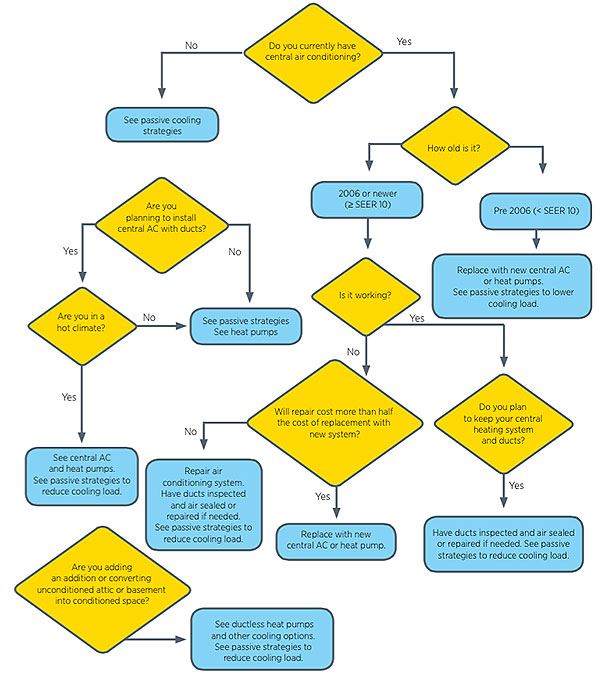
Austin A/C Cooling Systems
Travis County: Austin, Round Rock, Cedar Park, Pflugerville, Leander, TX
Air conditioning and other manufactured cooling systems are used throughout most of the country. This chapter describes typical cooling technologies, including air conditioning, heat pumps, evaporative cooling, radiant floor cooling, and dehumidifiers. However, with home improvements such as air sealing and insulating, in some climates home cooling needs can be met naturally, without the use of air conditioners, so fans, ventilation and passive cooling strategies are also described.
In moderate climates in a well-insulated home, passive cooling strategies like shading, low-solar heat gain windows, and radiant barriers can be combined with ceiling fans, ventilation, and dehumidification to eliminate or limit the need for air conditioning. These techniques should be considered before installing a new air conditioning system. See more information about natural cooling strategies, including the use of fans, night cooling, and passive cooling design techniques.
Many types of air conditioning systems are available, including central ducted air conditioners, room air conditioners, and heat pumps (both ducted and ductless). Evaporative coolers and radiant cooling are options in dry climates.
Over the past few decades, cooling systems have become much more efficient. In 2006, the federal government raised the minimum efficiency level for residential cooling equipment from SEER 10 to SEER 13. Heat pumps are more efficient than standard electric air conditioning and new models of ductless heat pumps offer SEER ratings as high as 26 at a wide outdoor temperature range.
The following sections describe the advantages and disadvantages of typical mechanical cooling systems and recommendations for maximizing the efficiency of your new system while reducing upfront costs. Precision can help you determine which system is best for your home.
Your choice will likely be influenced by the age and condition of your current system, the climate zone, cost, other remodeling activities, and energy-efficiency goals.

Here Are Some Things to Consider
- If you have a central air conditioning system, existing ductwork might be reused but have the duct system inspected before assuming it is usable. The ducts may have been installed poorly, gotten damaged over time, or be incorrectly sized for a new system.
- If you have a furnace but don’t have central air conditioning, it may be possible to incorporate it with your existing ductwork, depending on cooling load and sizing.
- If you do not have ductwork, installing ducts in an existing home may not be worth the cost (unless you are also installing a central furnace). Ductless mini-split heat pumps may be a good alternative.
- If you only plan on cooling sections or additions to your home, ductless heat pumps work well for zone cooling. Alternatively, window unit air conditioners can be used to cool individual rooms. Look for energy-efficient models.
Should I install a new central air conditioning system?
The decision tree and the cooling systems characteristics listed on this page may also help you in your decision-making process. The table below presents details on the most common of the cooling systems discussed, including an indication of cost. It also gives the Federal minimum efficiency rating (if established), the minimum ENERGY STAR efficiency criteria, and a range of efficiency levels for high-performing models you should look for if you are purchasing a new system.
